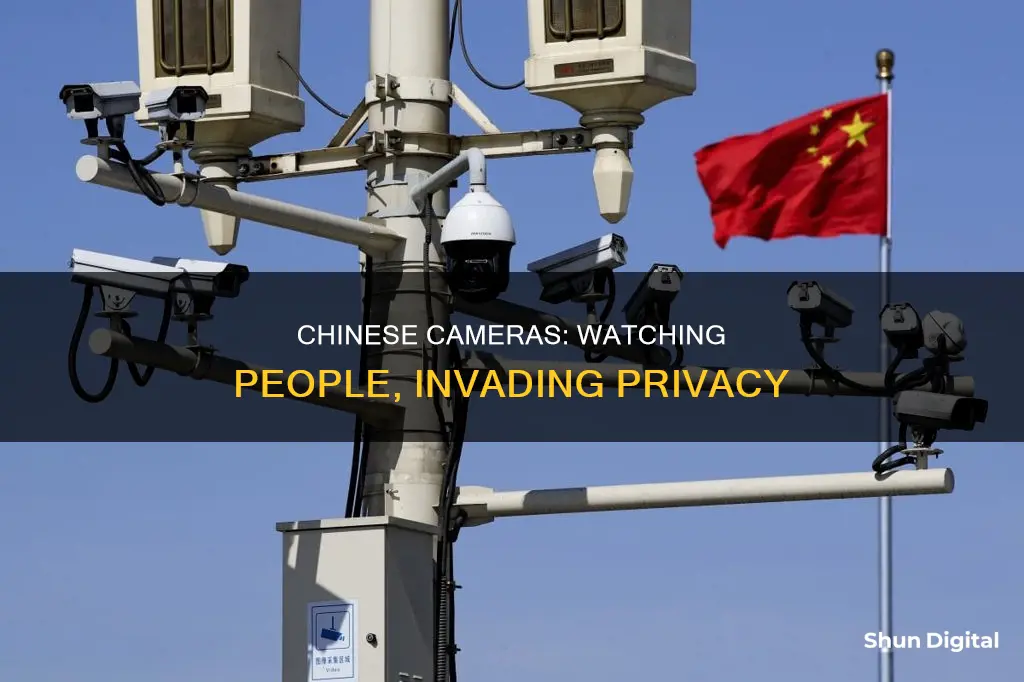
China's mass surveillance system is a network of monitoring systems used by the Chinese central government to watch its citizens. The system primarily involves camera surveillance, internet surveillance, and other digital technologies. The Chinese government has been strengthening its control over the internet and digital communication, with the number of surveillance cameras in the country reaching over 700 million as of August 2023. This has led to concerns about the privacy and data security of Chinese citizens, as well as criticism from governments and institutions worldwide.
| Characteristics | Values |
|---|---|
| Number of cameras | As of August 2023, there are over 700 million surveillance cameras in China, or one lens for every two citizens. |
| Camera locations | Cameras are placed in public spaces, such as streets, intersections, shopping districts, subways, and outside mosques in the Xinjiang region, temples in Tibet, and the homes of dissidents. |
| Technology | Facial recognition technology is used to access office buildings, identify and apprehend criminals, and shame jaywalkers. |
| Purpose | The Chinese government states that the surveillance system prevents crime and maintains public security. |
| Privacy concerns | Critics argue that the widespread surveillance violates internationally guaranteed rights to privacy and that the collection and use of biometric data should be limited to individuals involved in wrongdoing, rather than broad populations. |
| Social control | The surveillance system enables social control and has been linked to the suppression of dissent and targeting of specific groups, such as Uyghurs in Xinjiang. |
| Corporate involvement | Local companies such as Tencent, Dahua Technology, Hikvision, and others have contributed to the expansion of mass surveillance in China. |
| International impact | China exports its surveillance technology and AI-powered tools to authoritarian governments worldwide. |
What You'll Learn

Chinese cameras watch people in public spaces
The use of surveillance cameras in China has raised concerns among experts and critics, particularly in Hong Kong, where the local police have pursued an ambitious campaign to install thousands of additional cameras. While the police argue that the cameras are necessary to fight crime and improve public safety, critics warn that the technology could be used for political repression and infringe on civil liberties.
The Chinese government has defended its use of surveillance, stating that it helps solve crimes and maintain social stability. During the COVID-19 pandemic, the government also utilised surveillance technology to track people's health status and control the spread of the virus.
The impact of China's extensive surveillance network extends beyond its borders, with Taiwanese officials expressing concern about the surveillance of Taiwanese individuals living in mainland China. Additionally, foreign journalists travelling to Xinjiang have been tracked via Alibaba's police cloud system, and visitors to the region are reportedly forced to install a surveillance application on their devices.
The development and implementation of surveillance technology in China have been facilitated by both domestic companies and global tech companies, raising questions about the potential for harmful uses of this technology and the responsibility of those involved in its creation and deployment.
Apple Watch Series 4: Camera-Equipped Timepiece?
You may want to see also

Chinese cameras watch people in their homes
China has been expanding its mass surveillance network, which is used by the central government to monitor its citizens. This includes the use of camera surveillance, with an estimated 700 million surveillance cameras across the country as of August 2023. While these cameras are often placed in public spaces, there have been reports of cameras being installed inside people's homes, particularly during the COVID-19 pandemic.
Cameras in Homes During the Pandemic
During the COVID-19 pandemic, China implemented strict quarantine measures, including the use of surveillance cameras to monitor those in home quarantine. While there was no official announcement, several people reported having cameras installed outside their doors or even inside their homes. These cameras were used to ensure that individuals complied with quarantine rules and did not leave their homes. In some cases, community workers and police officers were involved in setting up these cameras, and the footage was monitored by community workers or police officers via smartphone apps.
One individual, William Zhou, reported that a camera was set up inside his home, pointing at his front door from a cabinet wall. He expressed concerns about the invasion of privacy and the psychological impact of being constantly monitored. He tried to have the camera removed but was unsuccessful, and was told that it would only capture still images when his door moved and would not record video or audio.
Cameras in Homes of School Children
In addition to pandemic-related surveillance, there have also been reports of parents in China installing cameras in their children's rooms to monitor their studying. This has sparked debates about the pressure on children to excel academically and the need for trust and independence. Legal experts have pointed out that under Chinese law, it is illegal for parents to surveil children aged eight and above without their consent.
The Impact of Surveillance
The widespread use of surveillance cameras in China has raised concerns about privacy and data protection. While the government claims that these measures are necessary for public safety and epidemic control, critics argue that they represent an intrusion into people's private lives. The ease of access to surveillance technology, such as security cameras and smartphone apps, has made it easier for individuals and authorities to monitor others, blurring the line between public and private spaces.
Big Brother: Is the Government Spying on Us?
You may want to see also

Chinese cameras watch people in classrooms
China has long been known for its extensive use of surveillance cameras, with the government citing it as a way to deter crime. However, many fear that the authorities are creating a surveillance state, both online and offline, to monitor citizens and suppress dissent. This issue has sparked some controversy, with critics arguing that it infringes on human rights and privacy.
In recent years, the use of surveillance cameras has expanded beyond public spaces and into classrooms. In 2018, Hangzhou No. 11 Middle School installed a "smart classroom behaviour management system" that uses artificially intelligent cameras with facial recognition tools to monitor students' expressions and movements, analysing them with big data to ensure they are paying attention. The system can detect expressions such as happiness, repulsion, fear, anger, and bewilderment, and students receive a real-time attentiveness score that is shared with their teacher.
Other schools in China have followed suit, and it is now common for classrooms to have multiple cameras installed. For example, Niulanshan First Secondary School in Beijing has three cameras in one of its biology classrooms. One camera is used for facial recognition, another for live-streaming, and the third is a backup. The Hangzhou school's vice principal claimed that after a month-long trial, students had accepted the monitoring and improved their behaviour. However, the use of these systems has sparked debate about privacy, educational ethics, and the potential negative impact of helicopter parenting.
While some argue that these systems improve student confidence and help teachers manage large classes, others raise concerns about the lack of consent and the potential for misuse of data. Students worry that their every move is being watched and that the data collected could affect their chances of attending their dream university. Additionally, there are questions about the accuracy and reliability of facial recognition technology, especially when it comes to identifying individuals with glasses or different hairstyles.
The Chinese government's "intelligent education" initiative has attracted companies eager to profit from bringing surveillance technology into classrooms. For example, a high school in Guangdong province has received criticism for forcing students to wear "smart bracelets" that track their location. The government has offered financial incentives to local education bureaus to encourage the use of big data and AI in schools, and it is expected that the number of surveillance cameras in China will continue to grow.
Paranormal Caught on Camera: Best Viewing Platforms
You may want to see also

Chinese cameras watch people in subways
In 2019, a Chongqing policeman received an alert from a facial recognition system, which had a high probability of matching a man caught on camera to a suspect in a 2002 murder case. Three days later, the police captured the man, who eventually admitted to being the suspect.
Facial recognition systems are not unusual in Chongqing, which has been part of the Xue Liang (Sharp Eyes) pilot scheme to tackle crime. The scheme ranks the trustworthiness of citizens and penalises or credits them accordingly. Many crimes committed in a certain area of Chongqing were committed by non-residents, so facial recognition cameras were seen as a way to combat this.
In 2020, Chinese law enforcement officials wore "smart helmets" equipped with AI-powered infrared cameras to detect pedestrians' temperatures amid the COVID-19 pandemic. The smart helmets used by the Chinese police also have facial recognition capabilities, license plate recognition, and the ability to scan QR codes.
Chinese cameras in subways watch people by using facial recognition to identify individuals and monitor their behaviour. This information is then used to penalise or credit them, depending on their trustworthiness.
Apple Watch Series 5: Camera Expectations Explained
You may want to see also

Chinese cameras watch people in airports
The mass surveillance system in China has expanded significantly under the PRC Cybersecurity Law (2016) and with the help of local companies. As of 2019, it is estimated that there are 200 million monitoring CCTV cameras in the Skynet system in mainland China, four times the number of surveillance cameras in the United States. By 2020, the number of surveillance cameras in mainland China was expected to reach 626 million. As of August 2023, the country had over 700 million surveillance cameras, according to online data—one lens for every two citizens.
The use of security cameras in China is on the rise, with cameras installed in highways, public parks, balconies, elevators, taxis, and even in the stands at sporting events. In Guangdong province, the government ordered hotels, guesthouses, hospitals, and places of entertainment to install cameras in all main rooms and reception areas. Airports, subways, and other modes of transport are the second most common use of surveillance cameras in China.
The Chinese government states that the cameras help fight crime and maintain "social stability." However, critics argue that the government uses them to monitor and intimidate dissidents and that the lack of legal restraints on surveillance raises concerns about Orwellian control over society. Human rights activists worry that the increasing surveillance will erode the freedom of ordinary people and undermine their ability to question their rulers.
In addition to monitoring the general public, the Chinese government has installed cameras outside mosques in the Xinjiang region, temples in Tibet, and the homes of dissidents. The surveillance system in China is not limited to camera surveillance but also includes internet monitoring, censorship, telecommunications, and law enforcement databases.
How ADT Monitors Your Security Cameras
You may want to see also
Frequently asked questions
As of August 2023, there were over 700 million surveillance cameras in China, which is approximately one lens for every two citizens.
The Chinese government uses surveillance cameras to monitor its citizens and enforce its laws. They are placed in public spaces, outside religious buildings, and the homes of dissidents.
Chinese surveillance cameras use facial recognition technology, which is integrated with big data and AI. This allows the government to identify and track individuals, as well as monitor online behavior.
Yes, there are concerns about privacy and human rights violations. Critics argue that the widespread use of surveillance cameras violates internationally guaranteed rights to privacy. There are also concerns about the potential for indiscriminate data harvesting and the technology being used for political repression.
The Chinese government claims that their surveillance measures are necessary for public security and to prevent crime. They also argue that similar measures are used in other countries, including Western democracies.







